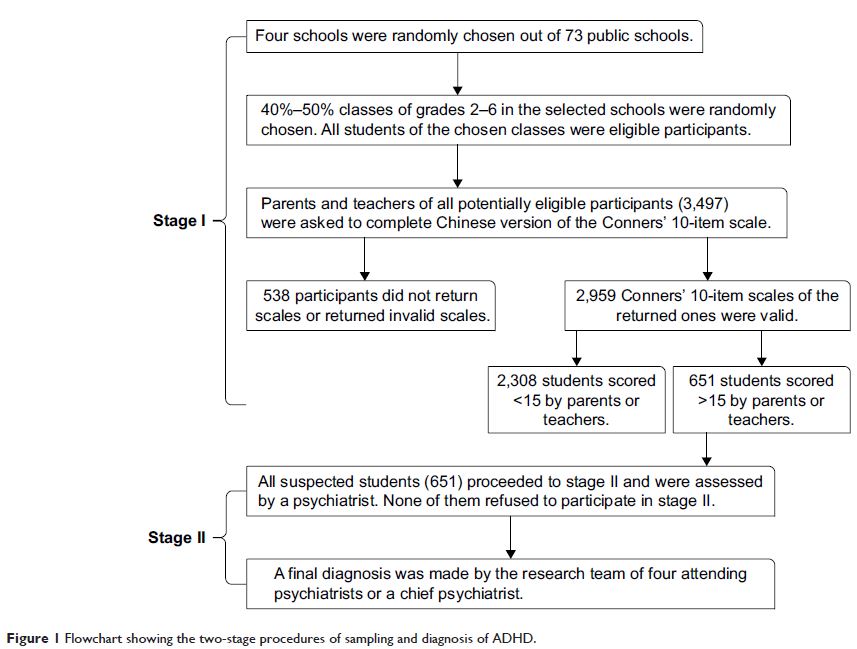108384
论文已发表
注册即可获取德孚的最新动态
IF 收录期刊
- 3.4 Breast Cancer (Dove Med Press)
- 3.2 Clin Epidemiol
- 2.6 Cancer Manag Res
- 2.9 Infect Drug Resist
- 3.7 Clin Interv Aging
- 5.1 Drug Des Dev Ther
- 3.1 Int J Chronic Obstr
- 6.6 Int J Nanomed
- 2.6 Int J Women's Health
- 2.9 Neuropsych Dis Treat
- 2.8 OncoTargets Ther
- 2.0 Patient Prefer Adher
- 2.2 Ther Clin Risk Manag
- 2.5 J Pain Res
- 3.0 Diabet Metab Synd Ob
- 3.2 Psychol Res Behav Ma
- 3.4 Nat Sci Sleep
- 1.8 Pharmgenomics Pers Med
- 2.0 Risk Manag Healthc Policy
- 4.1 J Inflamm Res
- 2.0 Int J Gen Med
- 3.4 J Hepatocell Carcinoma
- 3.0 J Asthma Allergy
- 2.2 Clin Cosmet Investig Dermatol
- 2.4 J Multidiscip Healthc

中国汕头小学生的注意缺陷多动障碍 (ADHD):患病率、亚型及影响因素
Authors Huang Y, Zheng S, Xu C, Lin K, Wu K, Zheng M, Zhang J, Xu H
Received 29 October 2016
Accepted for publication 24 January 2017
Published 14 March 2017 Volume 2017:13 Pages 785—792
DOI https://doi.org/10.2147/NDT.S126100
Checked for plagiarism Yes
Review by Single-blind
Peer reviewers approved by Dr Chin-Pang Lee
Peer reviewer comments 2
Editor who approved publication: Professor Wai Kwong Tang
Abstract: Attention-deficit hyperactivity disorder (ADHD) is a frequent
childhood-onset psychiatric condition and categorized into three subtypes of
predominantly inattentive (ADHD-I), hyperactive impulsive (ADHD-H), and
combined (ADHD-C). The prevalence and subtypes of ADHD vary considerably. The
primary aim of this study was to provide a prevalence estimate of ADHD in
elementary school students living in Shantou, a district of China, and in
addition to examine the influence of informants, age, and gender on the prevalence.
A total of 3,497 students aged 7–12 years were enrolled by random and
stratified sampling. In stage I, teachers and parents of all participating
students in randomly selected schools were asked to complete Chinese versions
of the Conners’ 10-item scale. In stage II, students with high scores (.15)
were interviewed by a psychiatrist for a diagnosis with or without ADHD.
Parents rated many more students with high scores than teachers did in stage I.
The prevalence of ADHD determined by Diagnostic and Statistical Manual of Mental
Disorders , fifth edition (DSM-5) was 5.91% (5.27%–6.55%), which is
comparable to the rates reported in previous studies with Chinese children.
This hits the low border of the ADHD prevalence range from 5.9 to 7.1%
worldwide, and is lower than that of Chinese children living in Hong Kong,
suggesting an important influence of Chinese culture on the diagnosis of ADHD.
The constituent ratios of ADHD-I, ADHD-C, and ADHD-H subtypes were 67.43,
24.57, and 8.00%, respectively. The rate of ADHD-H decreased with age, whereas
that of ADHD-I remained at the highest levels in all age groups, suggesting
that symptoms in the inattention domain are the most persistent and refractory.
Keywords: adolescents, ADHD, prevalence, Chinese
culture, informants
